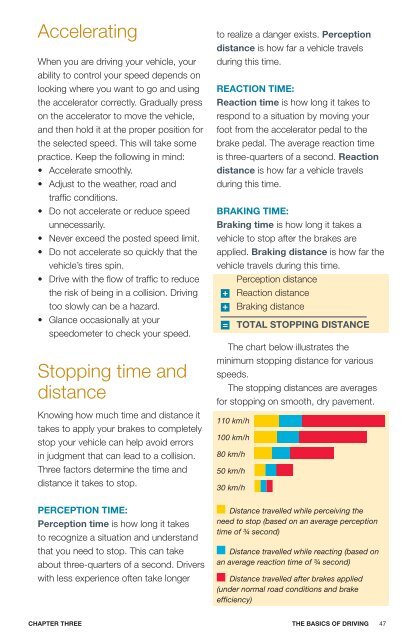DRIVER’S GUIDE
1POl7Ob
1POl7Ob
Create successful ePaper yourself
Turn your PDF publications into a flip-book with our unique Google optimized e-Paper software.
Accelerating<br />
When you are driving your vehicle, your<br />
ability to control your speed depends on<br />
looking where you want to go and using<br />
the accelerator correctly. Gradually press<br />
on the accelerator to move the vehicle,<br />
and then hold it at the proper position for<br />
the selected speed. This will take some<br />
practice. Keep the following in mind:<br />
• Accelerate smoothly.<br />
• Adjust to the weather, road and<br />
traffic conditions.<br />
• Do not accelerate or reduce speed<br />
unnecessarily.<br />
• Never exceed the posted speed limit.<br />
• Do not accelerate so quickly that the<br />
vehicle’s tires spin.<br />
• Drive with the flow of traffic to reduce<br />
the risk of being in a collision. Driving<br />
too slowly can be a hazard.<br />
• Glance occasionally at your<br />
speedometer to check your speed.<br />
Stopping time and<br />
distance<br />
Knowing how much time and distance it<br />
takes to apply your brakes to completely<br />
stop your vehicle can help avoid errors<br />
in judgment that can lead to a collision.<br />
Three factors determine the time and<br />
distance it takes to stop.<br />
PERCEPTION TIME:<br />
Perception time is how long it takes<br />
to recognize a situation and understand<br />
that you need to stop. This can take<br />
about three-quarters of a second. Drivers<br />
with less experience often take longer<br />
to realize a danger exists. Perception<br />
distance is how far a vehicle travels<br />
during this time.<br />
REACTION TIME:<br />
Reaction time is how long it takes to<br />
respond to a situation by moving your<br />
foot from the accelerator pedal to the<br />
brake pedal. The average reaction time<br />
is three-quarters of a second. Reaction<br />
distance is how far a vehicle travels<br />
during this time.<br />
BRAKING TIME:<br />
Braking time is how long it takes a<br />
vehicle to stop after the brakes are<br />
applied. Braking distance is how far the<br />
vehicle travels during this time.<br />
Perception distance<br />
+ Reaction distance<br />
+ Braking distance<br />
= TOTAL STOPPING DISTANCE<br />
The chart below illustrates the<br />
minimum stopping distance for various<br />
speeds.<br />
The stopping distances are averages<br />
for stopping on smooth, dry pavement.<br />
110 km/h<br />
100 km/h<br />
80 km/h<br />
50 km/h<br />
30 km/h<br />
Distance travelled while perceiving the<br />
need to stop (based on an average perception<br />
time of ¾ second)<br />
Distance travelled while reacting (based on<br />
an average reaction time of ¾ second)<br />
Distance travelled after brakes applied<br />
(under normal road conditions and brake<br />
efficiency)<br />
CHAPTER THREE<br />
THE BASICS OF DRIVING 47


